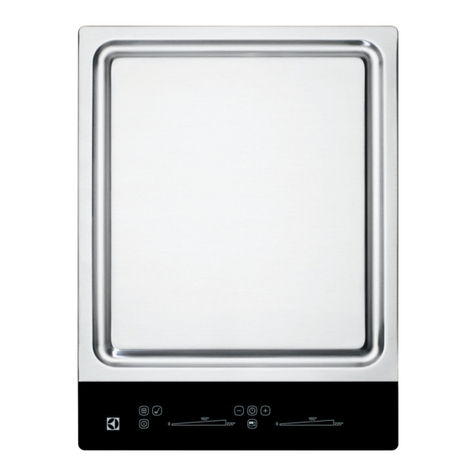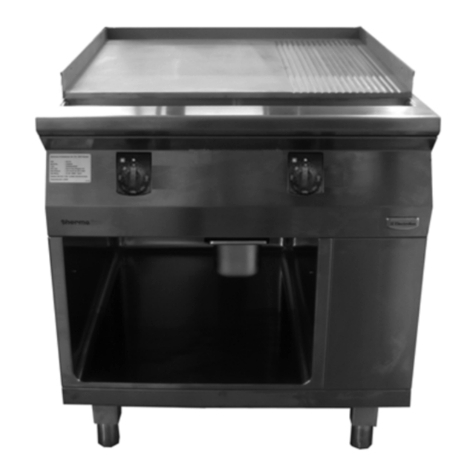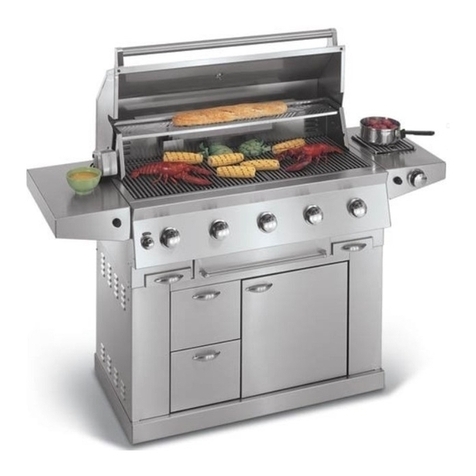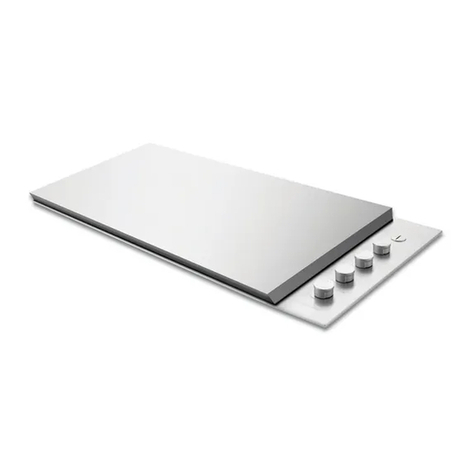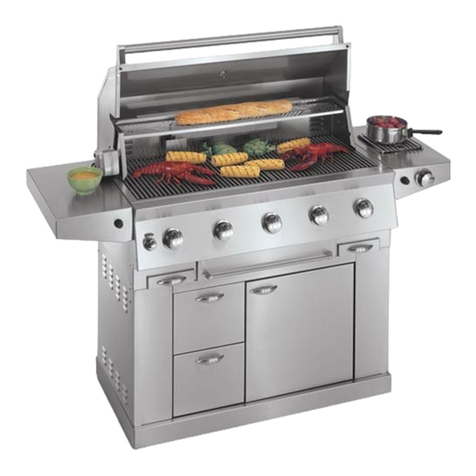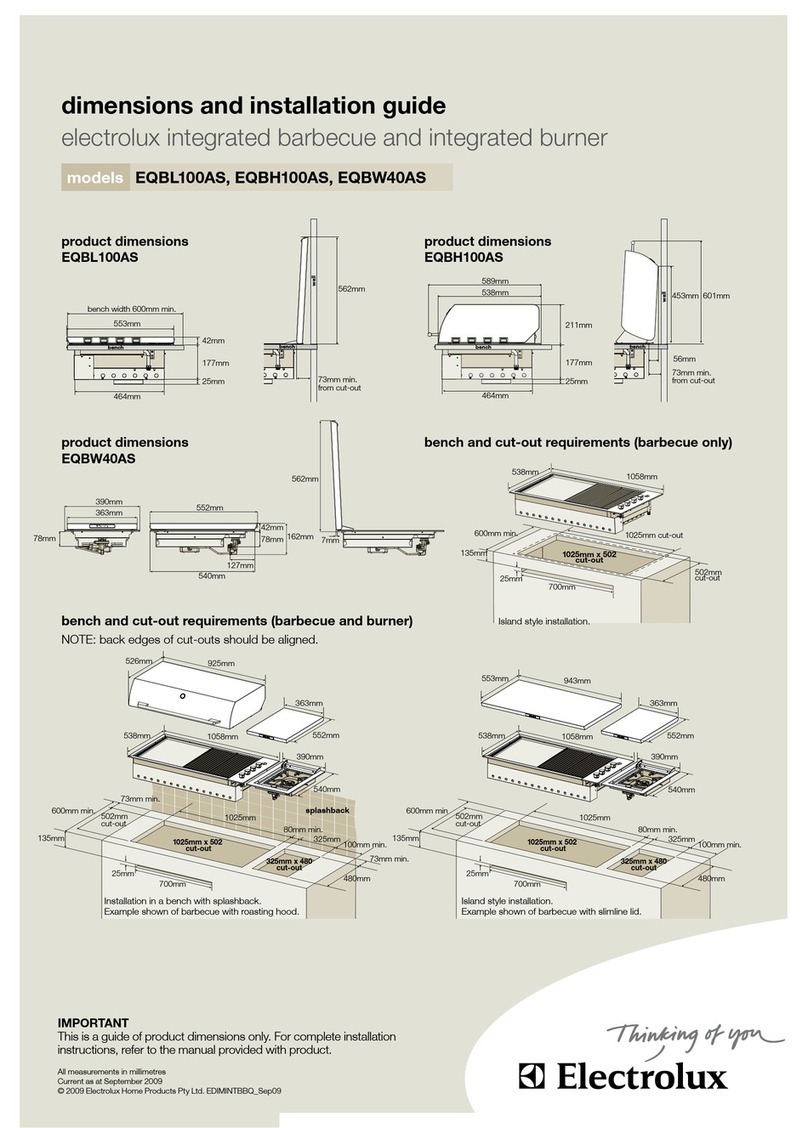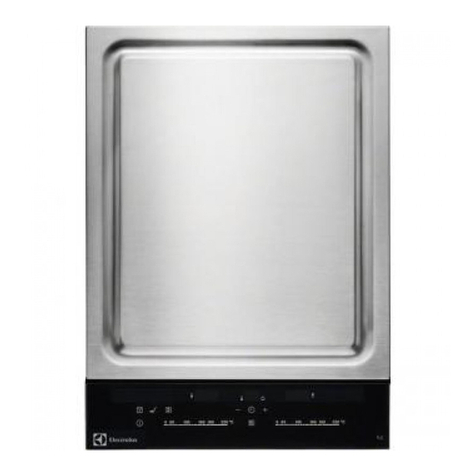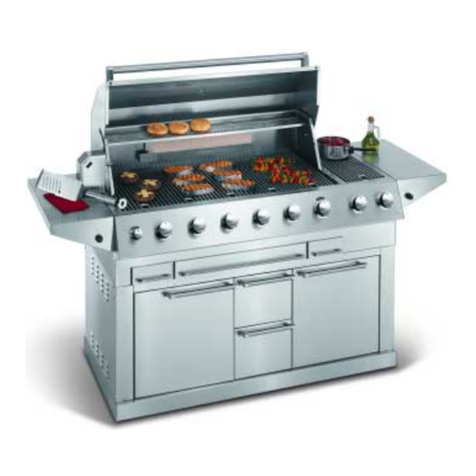5
ALWAYS FIT THE DRIP/BASTING TROUGH
MOUNTED ON THE FRONT BASE OF THE GRILL when
using the Brander, otherwise grease and juices from the
cooking food will drip directly onto the floor in front of the
grill.
ALWAYS EMPTY THE DRIP TROUGH BEFORE IT
BECOMES TOO FULL TO HANDLE SAFELY.
SCRAPE THE BRANDER PLATE FREQUENTLY
DURING COOKING PERIODS TO CLEAR CARBON
DEPOSITS.
The Brander Plate can be set at one of several angles within
the grilling compartment to suit various types of grilling. It
should always slope down towards the front. Locate the
Brander Plate upon it’s frame ensuring that the two pegs at
the rear of the frame engage in the two holes in the REAR of
the Brander Plate.
Engage the rearmost side pegs in the frame upon the
appropriate upper shelf runner, and push the Brander into the
grilling compartment. THEN engage the front side pegs of the
frame onto the lower shelf runner. Raising and lowering the
Brander, and increasing or decreasing the angle may be
carried out by changing the front peg position. The thicker the
cuts of meat, the lower the position of the Plate. It is not
advisable to leave the Brander Plate in a high position for
long periods of time with the heat full on. When using the
Brander Plate, the Plate must be placed in position in the
grilling compartment, and the grill turned on to HIGH for
about 20 minutes to pre-heat the Plate.
TO OBTAIN THE BEST RESULTS USING THE
BRANDER PLATE
1. Place the Brander Plate upon the Brander Frame with the
Frame’s pegs located in the holes at the back of the Plate.
Then position the Brander in the desired position within
the gill compartment.
2. Initially, try positioning the rear pegs on shelf four and the
front pegs on shelf two, until you are familiar with the
cooking performance.
3. Pre-heat the Plate for about 20 minutes with the burners
on HIGH.
4. When cooking, use the rear of the Brander, or raise the
position for Minute Steaks, and use the front, or lower the
position for cooking thick cuts and well done steaks.
Cooking should be completed without the need to turn the
food over if the Brander Plate has pre-heated for sufficient
time.
CLEANING
Cleaning is best carried out daily shortly after the grill has
been turned off - while it is still warm but not too hot.
DO NOT PLUNGE A HOT BRANDER INTO WATER -
TO DO SO CAN CAUSE IT TO DISTORT.
Heavy deposits should be scraped off the Brander Plate using
wood or plastic implements to avoid damaging the plate’s
surface. Soaking and washing in hot detergent solution should
be sufficient, with difficult areas being cleaned using a “grit-
free” proprietary cleaning agent. The use of ammonia and
caustic based cleaners should not be used as they attack the
metal - especially the aluminium Brander Plate. When
cleaning the interior of the grilling compartment, care must be
taken to avoid damaging the ceramic plaques of the burners.
Any deposits left on plaques will quickly burn off by
themselves.
Grills that are used continuously for cooking meat products
and where extensive use is made of basting, are likely to
became thickly coated externally and internally with grease
and carbonised fat. This is unhygienic and may became a
potential fire hazard. For this reason, the Outer Top Panel of
the Grill has been designed to be easily removed by the user,
allowing the Inner Top Panel to be removed from the grill for
cleaning.
1. Pull the Outer Top Panel foward and lift it clear of the
pegs in the tops of the the Outer Sides. Remove to the sink
for cleaning.
2. Lift the Inner Top Panel clear of the appliance and remove
to the sink for cleaning.
3. Carefully scrape any deposits from within the grill and
wash with a hot detergent solution. Dry WITH a lint-free
cloth.
4. Dry the Inner Top Panel, and place back into position.
5. Dry and polish the Outer Top Panel. Replace in position
by aligning the pegs with the key-hole slots (2 on each
side) in the return side flanges of the Outer Top Panel,
push the Panel firmly down onto the Outer Sides and then
push towards the rear of the grill until the back of the
panel lines up wigh the back of the grill.
THERE SHOULD BE NO GAP BETWEEN THE
OUTER SIDES AND THE OUTER TOP PANEL.
6. Re-light the grill on HIGH for a short period to thoroughly
dry off the unit.
7. The interior of the grilling compartment and the Inner Top
Panel will benefit from a light wipe-over using an lightly
oiled kitchen paper following cleaning.
8. The exterior panels of the grill are best cleaned using a hot
detergent solution followed by a rinse wipe-over and a
polish using a stainless steel cleaner.
DO NOT USE CAUSTIC BASED CLEANING
AGENTS ON THIS APPLIANCE.
MAINTENANCE
IMPORTANT: Maintenance must only be carried out by a
competent person (eg. one having CITB Certification and
CORGI Registration), and all work must comply with the Gas
Safety Regulations.
BEFORE DISMANTLING ANY GAS CARRYING
COMPONENT, TURN OFF THE GAS SUPPLY AT THE
ISOLATING TAP.
ROUTINE MAINTENANCE: Maintenance depends upon
the degree of use of the appliance, but should be carried out
on a regular basis. If an appliance is in daily use, in a busy
kitchen, then a minimum of four times a year is
recommended.
The following checklist, together with a thorough cleaning
programme, should provide optimum service and trouble-free
operation:
1. Remove the Outer Top, Inner Top Panel, and the
Control’s Fascia.
2. Remove the RH Outer Side Panel.
3. Examine the Piezo Ignition Cable for damage. Operate the
Igniter and observe the Cable, and the Pilot Ignition
Electrode for arcing. Replace if necessary.

